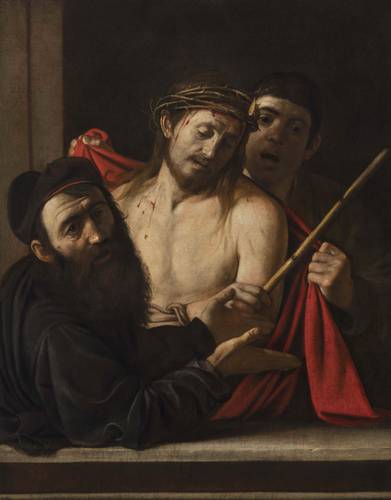▲ The work is a powerful example of Caravaggio’s mastery, (with) a skillful composition that presents a totally innovative three-dimensional and dynamic scene within the limits of a deep-rooted iconographic tradition
explained the director of the Museo del Prado, Miguel Falomir.Photo Ap
Madrid. The Prado Museum reported that it had reached an agreement with the owner of the painting Behold the manby Caravaggio, to be exhibited for nine months in the Madrid art gallery, where it had remained for restoration since it was located and its origin and authorship were investigated, which is now attributed without a doubt to the Italian artist.
The history of this jewel of art is unique. The first news of its existence was at an auction in April 2021, when the Prado Museum received an alert from the Spanish Ministry of Culture about the relevance of the painting after its reappearance at the Ansorena auction house. Then it had been announced as a piece attributed to a student of José de Ribera and that was going on sale with a price of 1,500 euros (28 thousand pesos). But suspicion immediately arose that the work was actually by Caravaggio, so it was decided that it would remain in the custody of the Colnaghi art gallery, in collaboration with Filippo Benappi (Benappi Fine Art) and Andrea Lullo (Lullo Pampoulides). .
After an in-depth diagnostic investigation carried out by Claudio Falcucci – a nuclear engineer specialized in the application of scientific techniques to the study and conservation of cultural heritage –, the restoration was carried out rigorously and each decision was supported by the exhaustive evaluation of the materials of the work and the conservation history of the painting, which further contributed to confirming the authorship of the Italian artist.
The oil painting represents the historical motif of the Roman governor Pontius Pilate presenting Christ to the people with the words Behold the man
(here is the man
), one of the most dramatic moments of the Passion, recorded in the Gospel of John. The work is a powerful example of Caravaggio’s mastery of the conception process: a skillful composition that presents a completely innovative three-dimensional and dynamic scene within the limits of a deep-rooted iconographic tradition.
explained the director of the Prado Museum, Miguel Falomir, who also confirmed that the Madrid art gallery had reached an agreement with its owner, a private collector, to exhibit it for nine months, starting on May 27.
He Behold the man by Caravaggio was painted approximately between 1605-1609 and, according to the historical research carried out to confirm its authorship, a possible written engagement in Rome between the artist and the aristocrat Massimo Massimi, signed on June 25, 1605, is mentioned. , in 1631, the work was part of the collection of Juan de Lezcano (secretary of Pedro Fernández de Castro, ambassador of Spain in Rome until 1616 and later viceroy of the court of Palermo, brother of Francisco de Castro, viceroy of Naples) . The work is later mentioned in the inventory prepared on the occasion of the departure to Madrid of the wife of García de Avellaneda y Haro Delgadillo, who was the second count of Castrillo (1588-1670) and viceroy of Naples (1653-1659).
Later, the Behold the man It was included in the private collection of Philip IV of Spain in 1666, and was later displayed in the home of his son Charles II between 1701 and 1702.
In 1789, the work was exhibited in the Royal Site of the Casa de Campo, until 1816 when it was documented in the Buenavista Palace in Madrid as part of the collection of Manuel Godoy (1767-1851), Secretary of State of Charles IV. and famous art collector. Upon Godoy’s death, the painting was transferred to the Royal Academy of San Fernando.
In 1821, Evaristo Pérez de Castro Méndez (1769-1849), a Spanish diplomat and honorary member of the Academy of San Fernando, received the Caravaggio in exchange for other paintings donated to the academy of fine arts. The work remained in the family until it changed ownership in 2024. Two years of intense research and restoration followed its rediscovery.
Jorge Coll, general director of Colnaghi, explained that In the last hundred years, no artist like Caravaggio, with his adventurous biography and unmistakable style, has fascinated so many people of all ages and attracted so many experts from around the world. This work therefore constitutes one of the greatest discoveries in the history of art and its sale marks the culmination of two years of work in collaboration with many leaders in their respective fields. I feel honored to have been part of this process and to have supported the incredible research and restoration process, which has confirmed and reinforced our first suspicion that the work is truly a masterpiece of its time, and also ours.
.
